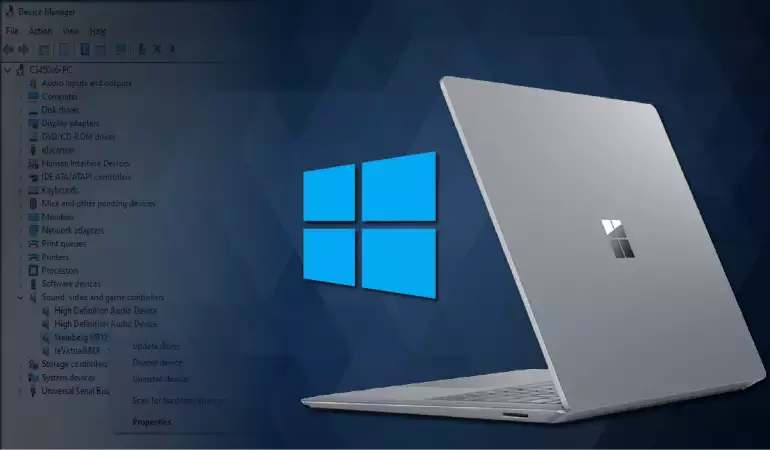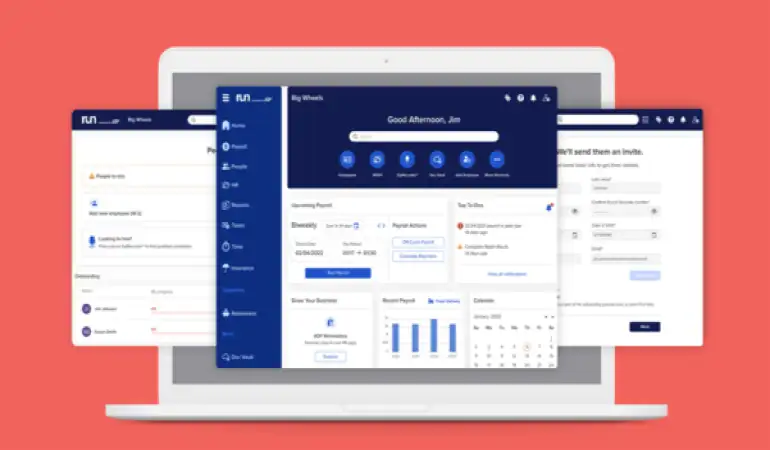How to Update Drivers in Windows - Step-by-step Guide
You might need to update drivers in Windows when a new piece of hardware doesn't work or after upgrading to a new version of Windows. Updating drivers may be a troubleshooting step when a device is having a problem or generating an error, like a Device Manager error code. An updated driver may also enable new hardware features, as with popular video cards and sound cards.
August 21, 2023 15:16
Imagine your system as a symphony, with each hardware component playing its part. When drivers are up-to-date, this symphony reaches its crescendo. Your system gains the advantage of improved performance, stability, and security.
Updated drivers often come with bug fixes, performance optimizations, and new features that ensure your hardware functions at its best. From faster graphics rendering for gamers to smoother multitasking for professionals, up-to-date drivers offer a tangible boost to your computing experience.
In the following sections, we'll delve deeper into the intricacies of updating drivers in Windows, uncovering the methods, tools, and precautions necessary to maintain an efficient and hassle-free system. Let's embark on this journey to harness the full potential of your hardware through the power of driver updates.
Why Updating Drivers Matters
A. Enhancing Communication between Hardware and Software
Drivers play a pivotal role in enabling seamless communication between your computer's hardware components and software applications. They serve as translators, converting complex hardware operations into language that software can understand. By keeping drivers up to date, you ensure that your operating system and applications can effectively communicate with hardware like graphics cards, printers, and network adapters. This translates into smoother performance and optimized functionality.
B. Preventing Compatibility Issues and Boosting Performance
Outdated drivers can create compatibility bottlenecks that hinder the performance of your system. As software evolves, it becomes increasingly demanding on hardware resources, and outdated drivers may struggle to keep up with these demands. This can result in sluggish performance, application crashes, and even system freezes. Regularly updating your drivers helps your system stay current and capable of handling modern software requirements, leading to a more responsive and efficient computing experience.
C. Mitigating Security Vulnerabilities
Security should always be a top priority, and outdated drivers can introduce vulnerabilities that attackers may exploit. Hackers often target outdated drivers to gain unauthorized access to your system, potentially compromising your sensitive data. When drivers are updated, manufacturers often address security loopholes that could be exploited. By neglecting driver updates, you could be leaving your system exposed to cyber threats. Keeping your drivers up to date ensures you have the latest security patches, reducing the risk of potential breaches.
However, updating drivers is not just a technical chore; it's a critical aspect of maintaining a secure, high-performance computing environment. Regularly checking for and installing driver updates guarantees optimal compatibility, performance, and security for your system.
Preparing for Driver Updates
When it comes to ensuring your system's stability and optimal performance, preparing for driver updates is a crucial step. This section will guide you through the necessary procedures, making the process seamless and efficient.
A. Creating a System Restore Point
To safeguard your computer's current state and data, it's wise to create a system restore point before proceeding with any driver updates. This precautionary measure can save you from potential compatibility issues or unexpected glitches.
1. Step-by-step instructions on creating a restore point:
* Click on the Start menu and type "Create a restore point" in the search bar.
* Select the matching result to open the System Properties window.
* In the System Protection tab, click on the "Create" button.
* Enter a recognizable description for the restore point to distinguish it from others.
* Click "Create" once more, then "Close" when the process is completed.
B. Identifying the Hardware and Current Driver Versions
To successfully update drivers, you need to pinpoint the hardware components that require updates and determine their current driver versions. This step ensures that you obtain the appropriate driver updates.
1. How to access Device Manager:
* Right-click on the Start menu and choose "Device Manager" from the context menu that appears.
* Alternatively, press Windows + X and select "Device Manager" from the list.
2. Locating the hardware devices that need driver updates:
* In the Device Manager window, browse through the listed categories to identify hardware devices with potential updates.
* Look for devices marked with a yellow triangle icon, indicating that there might be driver issues.
3. Finding current driver versions:
* Right-click on the hardware device that needs an update and select "Properties."
* Navigate to the "Driver" tab in the Properties window.
* Here, you'll find information about the current driver version and its release date.
By following these straightforward steps, you're now well-equipped to prepare your system for driver updates. This proactive approach will not only ensure a smooth update process but also guarantee the stability and optimal functioning of your computer.
Methods to Update Drivers in Windows
Keeping your device's drivers up to date is crucial for optimal performance and compatibility. Windows offers various methods to update drivers seamlessly. Here are some user-friendly approaches to ensure your system runs smoothly:
A. Windows Update
Windows Update is an automated solution to keep your drivers current without the hassle of manual intervention.
1. Automated Driver Updates: Windows Update is designed to automatically identify and install the latest drivers for your hardware components, such as graphics cards, printers, and network adapters.
2. Simple Steps to Utilize Windows Update:
* Click on the "Start" menu and select "Settings."
* Go to "Update & Security" and choose "Windows Update."
* Click "Check for updates" and let Windows search for available driver updates.
If updates are found, they will be installed automatically, enhancing your system's stability and performance.
B. Manufacturer's Website
Directly obtaining drivers from the manufacturer's official website ensures you have the most accurate and compatible updates.
1. Locating the Official Website: Search for your hardware manufacturer's official website using your preferred search engine.
2. Navigating to the Support or Downloads Section:
* Look for a "Support," "Downloads," or "Drivers" section on the manufacturer's website.
* Enter your hardware details or navigate through categories to find the specific driver you need.
3 Downloading the Latest Drivers: Once you've found the appropriate driver, download it and follow the provided instructions to install it on your system.
C. Device Manager
Windows' Device Manager allows you to manually update drivers for specific hardware components.
1. Accessing Device Manager: Right-click on the "Start" menu and select "Device Manager" from the list.
2. Updating Drivers:
* Locate the hardware device that needs an update in the device list.
* Right-click on the device and select "Update driver."
* Choose between searching for drivers manually on your computer or automatically searching online.
D. Third-Party Driver Updater Tools
While caution is advised, third-party driver updater tools can streamline the update process.
* Introduction to Third-Party Tools: Several tools can automate driver updates and save time.
* Exercising Caution: To avoid potential risks, only use tools from reputable sources. Stick to well-known and trusted software to prevent compatibility issues and security concerns.
By employing these methods, you can effortlessly keep your Windows drivers up to date, ensuring your system's performance remains top-notch while maintaining security and compatibility.
A Step-by-Step Guide to Easily Update Drivers on Your PC
A. Windows Update Method
Updating your drivers ensures your PC runs smoothly and efficiently. Here's a simple guide to updating drivers using various methods. Let's start with the Windows Update method:
1. Step 1: Open Windows Update Settings
Navigate to your PC's 'Settings' and click on 'Update & Security'. Then, select 'Windows Update' from the left-hand menu.
2. Step 2: Check for Updates
Click on the 'Check for updates' button. Windows will now search for available updates, including driver updates.
3. Step 3: Select and Install Driver Updates
If driver updates are available, they will appear under the 'Optional updates' section. Check the box next to the driver updates you want to install and click 'Download and install'. Windows will take care of the rest.
B. Manufacturer's Website Method
Sometimes, drivers aren't available through Windows Update. In such cases, you can follow these steps to manually update your drivers from the manufacturer's website:
1. Step 1: Find the Manufacturer's Website
Using your preferred search engine, find the official website of your hardware's manufacturer.
2. Step 2: Navigate to the Support Section
Once on the manufacturer's website, look for a 'Support' or 'Downloads' section. This is where you'll find driver updates.
3. Step 3: Search for Your Hardware Model
Enter your hardware's model number or name in the search bar. This will lead you to the specific driver downloads for your hardware.
4. Step 4: Download and Install the Latest Drivers
Identify the latest driver version compatible with your system. Download it and follow the manufacturer's instructions to install it.
C. Device Manager Method
Using the Device Manager, you can update drivers individually. Here's how:
1. Step 1: Access Device Manager
Right-click on the 'Start' button and select 'Device Manager' from the menu.
2. Step 2: Locate the Hardware Device
Expand the categories to find the hardware you want to update. Right-click on the device and select 'Update driver'.
3. Step 3: Update the Driver Manually
Choose 'Search automatically for updated driver software'. Windows will search online for the latest driver and install it.
D. Third-Party Tool Method
For a more automated approach, third-party tools can simplify driver updates:
1. Step 1: Research and Select a Reliable Tool
Search for reputable driver update tools online. Read reviews and choose one that suits your needs.
2. Step 2: Download and Install the Tool
Download the tool from the official website and follow the installation instructions.
3. Step 3: Scan for Outdated Drivers
Launch the tool and initiate a scan. The tool will identify outdated drivers on your system.
4. Step 4: Update Drivers Using the Tool's Interface
After scanning, the tool will present a list of outdated drivers. Follow the prompts to update them through the tool's interface.
By following these step-by-step methods, you can effortlessly keep your PC's drivers up-to-date, ensuring optimal performance and compatibility.
Verifying Driver Updates
When it comes to optimizing your system's performance, verifying driver updates is a crucial step. By keeping your drivers up-to-date, you can ensure that your hardware components and software applications run smoothly. Here are two essential methods to verify and update your drivers effectively:
A. Checking Device Manager for Updated Driver Versions
The Device Manager is a built-in Windows tool that allows you to monitor and manage your computer's hardware devices. To check for updated driver versions using Device Manager, follow these steps:
1. Open Device Manager: Right-click on the "Start" button and select "Device Manager" from the menu.
2. Expand Categories: Browse through the different categories to find the hardware device you want to update. Common categories include "Display adapters," "Network adapters," and "Sound, video, and game controllers."
3. Update Driver: Right-click on the device you want to update and select "Update driver." Choose the option to search automatically for updated driver software. Windows will then search for the latest driver version online and install it if available.
4. Restart if Necessary: After the update is complete, restart your computer to apply the changes.
B. Running Hardware and Software Tests for Improved Performance
Ensuring improved performance goes beyond just updating drivers. Running hardware and software tests can identify potential issues that might be hindering your system's efficiency. Follow these steps to perform tests for better performance:
1. Benchmark Tools: Utilize benchmarking software to assess your hardware's performance. These tools provide insights into your system's capabilities and help identify areas for improvement.
2. Stress Tests: Stress testing tools can push your hardware to its limits, uncovering any weaknesses. This can be particularly helpful for identifying overheating issues or stability problems.
3. Software Updates: Alongside hardware tests, ensure that your operating system and applications are updated to their latest versions. Software updates often include performance optimizations and bug fixes.
4. Driver Testing: Some third-party tools can analyze your installed drivers for compatibility and potential conflicts. This ensures that your drivers are working harmoniously with each other.
By combining driver updates with comprehensive hardware and software tests, you can achieve a noticeable boost in your system's performance. Regularly performing these steps will help you maintain a smoothly functioning computer and enhance your overall user experience.
However, verifying driver updates is a fundamental aspect of optimizing your computer's performance. Through the Device Manager's easy interface and running thorough hardware and software tests, you can ensure that your system operates at its best, providing a seamless and efficient computing experience.
Troubleshooting Common Issues
When it comes to maintaining your system's performance, driver updates play a crucial role. However, there are times when these updates can lead to unexpected problems. In this section, we'll guide you through resolving some of the most common issues that might occur during driver updates, ensuring a seamless experience for your system.
A. Addressing Potential Problems During Driver Updates
During the process of updating drivers, certain issues can crop up. These might include unexpected errors, system crashes, or peripherals not functioning correctly. To tackle these challenges effectively, consider the following steps:
1. Create a System Restore Point: Before initiating any driver updates, it's wise to create a restore point. This way, if something goes awry, you can revert your system to a stable state.
2. Check for Official Updates: Ensure that you're obtaining drivers from official sources, such as the manufacturer's website. Downloading drivers from trusted sources reduces the risk of compatibility issues.
3. Update One Driver at a Time: Rather than updating all drivers simultaneously, tackle them one by one. This approach makes it easier to pinpoint the driver causing trouble, in case an issue arises.
B. Solutions for Failed Driver Installations or Compatibility Issues
Encountering failed installations or compatibility problems is not uncommon. Fortunately, there are steps you can take to overcome these hurdles:
1. Uninstall Problematic Drivers: If a driver installation fails or causes issues, uninstall it completely. Then, download the driver from a reliable source and attempt the installation again.
2. Run Compatibility Troubleshooter: Most operating systems offer a built-in compatibility troubleshooter. Run this tool to identify and fix compatibility problems with drivers.
3. Roll Back Drivers: If a recently updated driver is causing problems, consider rolling back to the previous version. This can help to resolve compatibility issues until a stable update is available.
By following these strategies, you can navigate the potentially tricky terrain of driver updates with confidence. Troubleshooting common issues and finding effective solutions will keep your system running smoothly and your hardware performing optimally.
Conclusion
In summary, maintaining up-to-date drivers is a crucial aspect of ensuring optimal system performance and security. Throughout this guide, we have explored a range of effective methods to keep your drivers current and your system running smoothly.
By regularly updating your drivers, you not only unlock enhanced performance but also bolster the security of your system. Outdated drivers can lead to compatibility issues, decreased performance, and potential security vulnerabilities.
To ensure your system remains in top-notch condition, it's recommended to follow the methods discussed in this guide. Regularly checking for updates from official sources, utilizing automatic driver update tools, and staying informed about the latest driver releases are all vital practices.
In conclusion, investing a little time in driver maintenance goes a long way in ensuring your computer operates at its best. Keep those drivers updated and enjoy a seamless computing experience with improved performance and heightened security.











